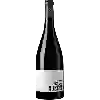
Winery GaydaFigure Libre Cabernet Franc
This wine is composed of 100% of the grape variety Cabernet Franc.
In the mouth this red wine is a powerful with a nice balance between acidity and tannins.
This wine generally goes well with beef, veal or pasta.
Taste structure of the Figure Libre Cabernet Franc from the Winery Gayda
Light | Bold | |
Smooth | Tannic | |
Dry | Sweet | |
Soft | Acidic |
In the mouth the Figure Libre Cabernet Franc of Winery Gayda in the region of Vin de Pays is a powerful with a nice balance between acidity and tannins.
Wine flavors and olphactive analysis
On the nose the Figure Libre Cabernet Franc of Winery Gayda in the region of Vin de Pays often reveals types of flavors of cherry, cassis or floral and sometimes also flavors of black fruit, red fruit or bell pepper.
Food and wine pairings with Figure Libre Cabernet Franc
Pairings that work perfectly with Figure Libre Cabernet Franc
Original food and wine pairings with Figure Libre Cabernet Franc
The Figure Libre Cabernet Franc of Winery Gayda matches generally quite well with dishes of beef, pasta or veal such as recipes of ramen burger, pasta with basil or shoulder of lamb stuffed with cognac.
Details and technical informations about Winery Gayda's Figure Libre Cabernet Franc.
Discover the grape variety: Cabernet franc
Cabernet Franc is one of the oldest red grape varieties in Bordeaux. The Libourne region is its terroir where it develops best. The terroirs of Saint-Emilion and Fronsac allow it to mature and develop its best range of aromas. It is also the majority in many blends. The very famous Château Cheval Blanc, for example, uses 60% Cabernet Franc. The wines produced with Cabernet Franc are medium in colour with fine tannins and subtle aromas of small red fruits and spices. When blended with Merlot and Cabernet Sauvignon, it brings complexity and a bouquet of aromas to the wine. It produces fruity wines that can be drunk quite quickly, but whose great vintages can be kept for a long time. It is an earlier grape variety than Cabernet Sauvignon, which means that it is planted as far north as the Loire Valley. In Anjou, it is also used to make sweet rosé wines. Cabernet Franc is now used in some twenty countries in Europe and throughout the world.
Last vintages of this wine
The best vintages of Figure Libre Cabernet Franc from Winery Gayda are 2016, 2015, 2009, 2017 and 2014.
Informations about the Winery Gayda
The Winery Gayda is one of of the world's greatest estates. It offers 48 wines for sale in the of Pays d'Oc to come and discover on site or to buy online.
The wine region of Pays d'Oc
Pays d'Oc is the PGI for red, white and rosé wines that are produced over a wide area of the southern coast of France. The PGI catchment area corresponds roughly to the Languedoc-roussillon">Languedoc-Roussillon wine region, one of the largest wine regions in France. The area covers all wines that are not produced under the strict laws that govern AOC-level appellations in the regions: among them, Corbières, Minervois and the Languedoc appellation itself. The Pays d'Oc PGI is arguably the most important in France, producing the majority of the country's PGI wines.
The wine region of Vin de Pays
Vin de Pays (VDP), the French national equivalent of PGI (Protected Geographical Indication) at the European level, is a quality category of French wines, positioned between Vin de Table (VDT) and Appellation d'Origine Contrôlée (AOC). This layer of the French appellation system was initially introduced in September 1968 by the INAO, the official appellation authority. It underwent several early revisions in the 1970s, followed by substantial changes in September 2000 and again in 2009, when all existing VDT titles were automatically registered with the European Union as PGI. Producers retain the choice of using either the VDP or PGI titles on their labels, or both - in the form "IGP-Vin de Pays".
News related to this wine
Geographical denomination: The first step towards the notion of terroir – Focus Bourgogne
We created this photomontage, to show you the landscapes and the different characteristics of the 14 geographical denominations of the Bourgogne appellation: Wine colors, grape varieties, soil specificities, surface area and production. You’ll become an expert on the Bourgogne appellation! Our social media: Facebook: https://www.facebook.com/BourgogneWines Twitter: https://twitter.com/BourgogneWines/ Instagram: https://www.instagram.com/vinsdebourgogne/ LinkedIn: https://www.linkedin.com/comp ...
The Mâcon plus appellation seen by Théo et Hugo Merlin
Théo and Paul Merlin are winegrowers at the Domaine Merlin, they emphasizes the characteristics of the appellation Mâcon La Roche Vineuse. This video is taken from the “Rendez-vous avec les vins de Bourgogne” program (March 2020). Our social media: Facebook: https://www.facebook.com/BourgogneWines Twitter: https://twitter.com/BourgogneWines/ Instagram: https://www.instagram.com/vinsdebourgogne/ LinkedIn: https://www.linkedin.com/company/bivb Find out more on our website: https://www.bourgogn ...
At the heart of the terroirs of Mâcon-Chardonnay
Sequence from the video « At the heart of the Mâcon terroir » which offer a stroll at the heart of the Mâcon terroir. It offers a focus on Mâcon-Chardonnay, one of the 27 geographical denominations of the Mâcon appellation. Travel through the terroirs of the Mâcon appellation by watching the full video : https://www.youtube.com/watch?v=GF20y1aBZh8 Both are available in French and English. Our social media: Facebook: https://www.facebook.com/BourgogneWines Twitter: https://twitter.com/Bourgogne ...
The word of the wine: Double magnum (or Marie-Jeanne)
Bottle with a capacity of 3 litres.














